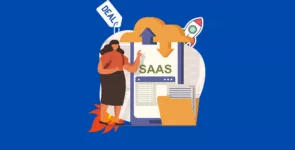Digital-first business leaders are constantly looking for the next ‘big thing’ in tech to put them ahead of the curve. Back in the noughties, it was operation-improving software. In the 2010s, it moved to cloud-based Software-as-a-Service (SaaS). Cut to the 2020s, it’s all about optimizing your organization’s SaaS portfolio.
Popular SaaS products from Microsoft, Google, Salesforce and more can assist with every business function from marketing to HR. So, it’s no wonder that we’re adding them to our IT portfolios in droves. However, the proverb goes that you can indeed have too much of a good thing — and as companies have accumulated many subscriptions over time, they have unwittingly created inefficiencies that hinder their progress.
So, what can be done to streamline your SaaS stack and restore the benefits of a well-oiled portfolio? Enter application rationalization.
What is application rationalization?
Software application rationalization is the process of assessing your organization’s SaaS portfolio to identify which subscriptions should be retained and which should be consolidated or terminated. The rationale behind the process is to justify the continued use of each tool within the company, by determining which provide business value and which do not.
This typically involves assessing the utilization, performance, and costs associated with each tool in relation to the wider SaaS stack.
Once audited, the applications that are deemed less valuable to business growth can have their number of licenses rightsized or be canceled altogether. This way, you’ll be left with a lean, productive suite of applications that provide an improved return on investment.
How can it assist your business?
Many business leaders are aware that application rationalization can help them to identify and cut unnecessary costs, However, the benefit that is often overlooked is that rationalization can also improve business productivity.
With a streamlined portfolio, companies can enjoy the following benefits for their operations:
1. Fewer workflow inefficiencies
One key benefit of application rationalization is the elimination of workflow inefficiencies that stem from redundant tools. As businesses scale, it’s natural to accumulate subscriptions that overlap in functionality or even duplicate subscriptions to the same product. These incur unnecessary extra costs in terms of both time and resources, with fragmentation in workflows, delays in passing through approvals, and file management confusion.
However, application rationalization can identify these redundancies and support organizations in making informed decisions. It also helps to identify any instances of shadow IT, the use of unauthorized systems for work purposes, which 80% of employees admit to.
As a result, the company can identify the most suitable, valuable tools to prioritize, and terminate subscriptions to others. For example, a business might be using three separate project management tools, each with its own feature set and user base across the organization. Once rationalized, the company can migrate all projects to one ecosystem, streamline project management processes, and reduce confusion.
2. Higher employee engagement
Though they’re built to make life easier, an over-provisioning of software tools can actually hinder your employees — and provide a source of frustration as they try to complete their work. According to project management specialists at Asana, context switching between different apps, tasks and projects is a distraction that stresses out workers and makes them less productive as a result.
But this isn’t news to your staff. One report from Personio asked employees how they feel about their software use in the workplace and found that 37% believe they have too many apps to manage, while 36% claim it disrupts their workflow. Instead of entering deep work, many employees spend valuable time out of their day grappling with unfamiliar tools and tedious software administration.
Application rationalization helps to optimize software use and boost employee morale. When organization trim their portfolio to a leaner suite of tools, staff can enjoy a more fruitful experience at work. This is because they will become proficient in a smaller set of tools, increasing both their productivity and job satisfaction.
3. Streamlined management and procurement processes
As we’ve discussed, application rationalization offers a number of immediate gains for business productivity. However, the process also lays the groundwork for future SaaS management. By maintaining a leaner software portfolio, organizations reduce the complexity of managing licenses, updates, and renewals — resulting in lower administrative overhead and more efficient resource allocation.
This also supports decision making when it comes time to purchase new tools. According to Statista, the average organization now deploys 130 different applications, which has increased consistently since 2015. At the current rate of growth, this is unsustainable for many businesses. However, application rationalization helps to identify gaps in your current software ecosystem so that you can make select and strategic new acquisitions rather than add to your stack indiscriminately.
This results in a cost-effective and agile procurement process which is less likely to fall foul of the pitfalls of portfolio bloating.
So, with a leaner stack of existing tools, you save time and resources in daily operations, SaaS management, and new procurement, all the while improving employee engagement. Application rationalization is no quick process, but offers one of the greatest returns on investment in SaaS — productivity benefits that will last for years to come.
Written by Lara Harper








